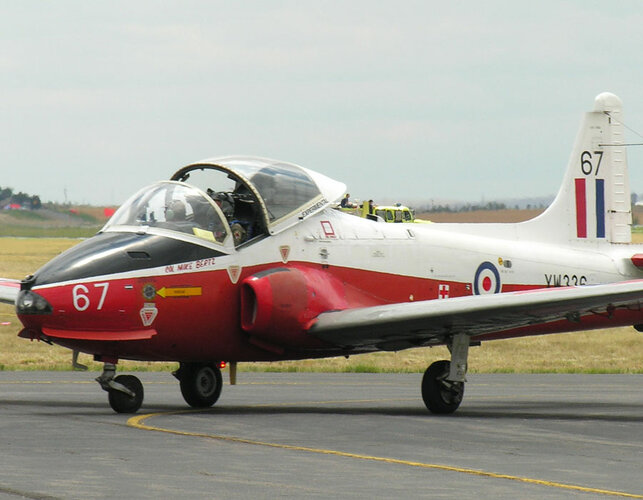JAZZ
ACCESS: Secret
- Joined
- 11 March 2006
- Messages
- 304
- Reaction score
- 353
NGT submissions (as in 1981) include General Dynamics M-210, Gulf Stream, Rockwell Nova. I include a Fairchild design concept looking like a mini A-10.
Great set of pictures, but the last image represents the Rutan/Ames Model 73 demonstrator, not the T-46.
Source: Flight International - 19th December 1981SELECTION of the US Air Force Next Generation Trainer (NGT) is expected in the spring, reports Bill Sweetman from California. Five companies have submitted final technical proposals for a primary jet trainer to replace the Cessna T-37. Cost proposals were due in by December 14. The USAF requires 600 NGTs from the late 1980s. Of the five companies sponsored through contract definition, Vought and General Dynamics have declined to respond to the final request for proposals. This eliminates the Vought/VFW Eaglet, a Fantrainer derivative and the only "offshore" element in the competition. Surviving contract definition are Cessna, Fairchild, and Rockwell. Cessna, having started out with a proposal to re-engine and update existing T-37s, is now offering what amounts to a new aircraft. Retaining the basic
T-37 mid-wing layout, Cessna's NGT sub-scale has new engines, redesigned cabin with pressurisation and ejection
seats, a larger wing, and a T-tail. Fairchild's approach to the competition includes a piloted prototype used to substantiate technical data. The total cost of $500,000 is comparable with the expenditure required to gather the same data through windtunnel testing, says Fairchild. The prototype is a 1,5001b, 0-62-scale model, built in foam-cored
glassfibre by Burt Rutan's organisation at Mohave, California. The exact scale was determined by the output of the most readily available FAAcertificated engines, two Microturbo TRS-18s of 2201b thrust each. In 18 flights, totalling 20-8hr, the prototype explored deep stall, aggravated stall, and post-stall flight regimes; confirmed windtunnel predictions of stability and damping in all axes; and demonstrated that the twin tail layout is spin-resistant. No spins were performed, but the aircraft was observed at sideslip angles of 30° using asymmetric thrust. Rockwell's Near-term Optimum Value (Nova) trainer was unveiled in mock-up form some time ago. Proposed when the company's North American Division was short of work following the cancellation of the B-1A, Nova's prospects may be harmed by President Reagan's decision to build 100 B-1B's.Gulfstream American, not one of the original five contenders, is proposing the Peregrine. The sole prototype has passed the 50hr mark in flight-tests at Bethany and Savannah "with no major problems". A few changes have been made, including adding anhedral to the wing. Gulfstream American will offer the Peregrine for export irrespective of the outcome of NGT. Smallest of the five airframe bidders is Ensign Aircraft, based near Long Beach, California. Previously engaged in subcontract design, manufacture, and engineering, including assistance with some certification programmes, Ensign began privateventure work on NGT designs in February 1980. Ensign's EA-12 NGT design is entirely conventional, but makes the greatest use possible of advanced automated manufacturing processes in its production. This, Ensign believes, would cut production overheads and make it more economical for the USAF to slow or suspend production without increasing unit costs or incurring high restart expenses. Ensign considers that this approach favours the new contractor, especially the aircraft itself presents a few technical challenges.
Apparently Promavia asked Stelio Frati to design the Jet Squalus - basically a jet-powered SF.260 - to meet the NGT requirement. No idea if it was ever offered.











Spent an enjoyable day with Gerald Balzer yesterday and came across a few things I had not found before. The man has an amazing collection!
Here is a photo of the Rockwell Nova NGT mockup, courtesy of the Gerald Balzer Collection.
Enjoy the Day! Mark

My question is, was that a result of changes in training procedures, or to meet cost goals by reducing frontal area => drag => operating costs?One of the interesting points is how the USAF then was convinced side-by-side seating was preferable for NGT while at the same time the RAF had reverted back to tandem seating for its AST.412 (Tucano).
The merits of both layouts have been heavily debated and researched but side-by-side trainers now seem to be largely extinct for military basic and advanced training. Only elementary training using standard civil trainers retains side-by-side.
A mix of both, mainly training procedures.My question is, was that a result of changes in training procedures, or to meet cost goals by reducing frontal area => drag => operating costs?
harder to monitor student's switch selection in a wide cockpit
Sounds to me like switches were (are?) just a big risk in trainers, regardless of where the instructor is sitting!greater risk of mis-selecting switches as student unmonitored
Hi,
and from Cessna,a modern T-37.
In case you missed my previous posting, now residing on my shelf.Early Gulfstream NGT designs before they settled on the Peregrine.
